#Eco-Friendly Heat Protection
Explore tagged Tumblr posts
Text
Summer - ಬೇಸಿಗೆಯ ಬಿಸಿಲಿಂದ ರಕ್ಷಣೆಗಾಗಿ ಐಷಾರಾಮಿ ಕಾರಿಗೆ ಹಸುವಿನ ಸಗಣಿ ಲೇಪನ ಮಾಡಿದ ಆಯುರ್ವೇದ ತಜ್ಞ; ವಿಡಿಯೋ ವೈರಲ್…!
Summer – ಬೇಸಿಗೆಯ ತಾಪ (Summer Heat) ಈಗ ಎಲ್ಲೆಡೆ ತನ್ನ ಪ್ರಭಾವವನ್ನು ತೋರಿಸುತ್ತಿದೆ. ಈ ವರ್ಷದ ಆರಂಭದಿಂದಲೇ ಸೂರ್ಯನ ಶಾಖ (Sun Heat) ತೀವ್ರವಾಗಿದ್ದು, ಜನರು ಬಿಸಿಲಿನ ಸೆಖೆಯನ್ನು (Heatwave) ತಡೆದುಕೊಳ್ಳಲಾಗದೆ ತೊಂದರೆ ಅನುಭವಿಸುತ್ತಿದ್ದಾರೆ. ಮನೆಯೊಳಗೆ ಇರಲಿ ಅಥವಾ ವಾಹನದಲ್ಲಿ ಏರ್ ಕಂಡೀಷನರ್ (AC) ಬಳಸಿದರೂ, ತಾಪಮಾನ (Temperature) ಕಡಿಮೆಯಾಗದಿರುವ ಬಗ್ಗೆ ಜನರು ದೂರುತ್ತಿದ್ದಾರೆ. ಮಹಾರಾಷ್ಟ್ರದ ಪಂಢಪುರದ ಆಯುರ್ವೇದ ತಜ್ಞ (Ayurvedic Expert) ಡಾ. ರಾಮ್ ಹರಿ ಕದಮ್…
#Ayurvedic Cooling Method#Cow Dung Coating on Car#Eco-Friendly Heat Protection#Heatwave Survival Tips#Home Cooling Solutions#Mahindra XUV 300 Cooling Experiment#Natural Cooling Technique#Summer Heat Protection#Traditional Indian Cooling Methods#Viral Video India 2025
0 notes
Note
Can u write reader and professor ellie taking care of Aurora while she’s on her period😭or like how they reacted and managed with her when she started being a teen
I love the professor ellie series!!💜💜
Headcannons: professor!ellie williams x reader

masterlist
professor ellie masterlist
☆ Ellie notices something’s off before Aurora even tells anyone—her daughter’s unusually quiet, subdued, curled up on the couch with a heat pack she likely snuck from the bathroom.
☆ She pauses mid-lecture grading when she gets a text from you: “Aurora got her period. She wants to talk to you too.” Ellie nearly drops her pen.
☆ Ellie rushes home, barely bothering to organize her research notes. She finds Aurora in bed, flushed and moody, and her heart breaks in the softest way.
☆ “My baby’s growing up,” Ellie whispers under her breath as she kneels beside Aurora’s bed, brushing her hair out of her face.
☆ Aurora is embarrassed, but Ellie makes it all scientific. She talks about hormones, menstruation as a biological marvel, how it’s a sign of health and maturity—her academic comfort zone.
☆ But behind the calm, Ellie is spiraling. She hugs you that night tighter than usual, muttering, “She was just in diapers. I remember the hospital smell.”
☆ Ellie becomes overly meticulous, ordering a dozen types of eco-friendly pads and period underwear. “We should get her a menstrual tracking journal. Actually, I’ll design one. I’ll code the app.”
☆ You catch her staring at Aurora’s baby pictures that night, eyes glassy. “She used to sleep on my chest every night,” she murmurs. “Now she barely wants a hug.”
☆ Ellie insists on giving Aurora a full menstrual health crash course—whiteboard diagrams, booklets she prints out herself. Aurora begs her to stop.
☆ “You are a miracle of biology,” Ellie tells Aurora proudly, cupping her face. “Do you understand how powerful this makes you?”
☆ She accidentally calls it Aurora’s “menarche” one too many times before Aurora yells from the bathroom, “Stop calling it that, Mom!”
☆ Ellie tries to make it celebratory. She buys her daughter her favorite dessert and a bouquet of red roses. Aurora is horrified. You laugh. Ellie sulks.
☆ At night, Ellie overthinks. “What if she gets cramps like you did? What if she misses school? What if the boys—”
☆ “I swear if a boy says something dumb to her, I will break the school board in half,” Ellie hisses to you while brushing her teeth.
☆ She starts leaving small care packages in Aurora’s room: chocolate, heat packs, handwritten notes that say “You’re stronger than you feel.”
☆ She writes in her research journal about it—“Transgenerational development of daughters: the maternal lens of biological transition.”
☆ Ellie pulls out your old pregnancy journals, the ones you kept when Aurora was in your belly, and reads them late at night.
☆ She becomes more protective than ever. Any eye roll from Aurora is met with quiet over-analysis. “Is it hormones? Did I do something wrong?”
☆ She talks to Arnold too. “Your sister might be more sensitive right now. You have to be patient. Gentle.” Arnold, chewing cereal, goes, “Okay. Can I still prank her?”
☆ Ellie insists on giving Aurora a key to a “quiet box” of supplies in her office, in case she ever gets her period at school. “Biological emergencies require strategic preparedness.”
☆ Ellie writes a personal letter to Aurora she hides in a journal: it’s emotional, raw, academic, filled with references to feminist theory and the sacredness of menstruation. Aurora won’t find it for years.
☆ She clings to you that week. Every time Aurora slams a door or retreats into music, Ellie comes to you like she’s been stabbed. “Tell me she still needs me.”
☆ Ellie creates a folder on her computer called “Aurora - Adolescence: Phase I.” It contains spreadsheets tracking patterns and emotional shifts.
☆ She’s emotional watching Aurora brush her own hair, apply lip gloss, and adjust her hoodie like a woman. “She looks like you,” she whispers to you.
☆ “It’s not just her growing up,” Ellie finally admits one night. “It’s the countdown. Soon she’ll be gone. It’s like…I’m losing time.”
☆ Arnold feels a little left out. Ellie is hyper-focused on Aurora, and he starts intentionally acting sillier to get her attention.
☆ He pretends to be sick so he can stay home too. Ellie sees right through it, but hugs him anyway and lets him stay.
☆ Ellie gives Arnold “brother missions”—small tasks like heating up Aurora’s hot water bottle or picking her favorite snacks.
☆ She builds his confidence by reminding him he’s the little man of the house—while also telling him, “Never assume you understand a woman’s pain.”
☆ Ellie starts a “boys growing up” project for Arnold—teaching him hygiene, boundaries, and how to talk about emotions. She pulls research from three parenting psychology journals.
☆ Aurora slaps his arm one day when he teases her. Ellie pulls them both aside for a long talk about mutual respect and hormonal volatility. They both groan in sync.
☆ Arnold is the first one to tell Ellie when Aurora starts crying at a commercial. “Mom, she’s leaking from her eyes again. Help?”
☆ Ellie starts planning more one-on-one time with Arnold, taking him to museums, science fairs, or just letting him help with her university lectures.
☆ Arnold asks if girls are going to be “weird forever.” Ellie gives him a 20-minute TED Talk. He regrets asking.
☆ Ellie sets up a whiteboard in the kitchen with color-coded schedules: Aurora’s cycle (secretly coded), Arnold’s soccer, your appointments. It looks like a military base.
☆ Ellie uses every chance to teach emotional awareness. When Arnold asks, “Is Aurora dying?” Ellie goes, “No, buddy. She’s blooming.”
☆ You notice that Ellie gets more clingy with Arnold too—like she’s subconsciously bracing for him growing up next. She kisses his hair constantly.
☆ Ellie insists they both watch “Turning Red” together. She ends up crying harder than Aurora or Arnold.
☆ Ellie buys a book titled “Parenting Emotional Teens and Tactical Preteens.” She highlights every other page and forces you to read it.
☆ When Aurora teases Arnold about still sleeping with his stuffed dino, Ellie snaps: “He can do that until college. Leave him alone.”
☆ You find her staring wistfully at a baby in the grocery store. “That smell. That tiny head. Look how the mother holds them,” she murmurs like she’s hypnotized.
☆ Aurora’s transition makes Ellie acutely aware of the passage of time. “It went so fast. I missed so much.”
☆ Ellie asks you, gently, cautiously, “Would you ever… want to do it again?”
☆ She starts bringing up embryo storage again—talking about the ones you froze during Aurora and Arnold’s IVF rounds.
☆ She even looks into donor matches, mapping out compatibility charts late at night with that hyper-focused intensity in her eyes.
☆ Ellie watches old videos of you pregnant. She pauses every time the camera pans to her—how young she looked, how in love.
☆ “We were just kids,” she says, her fingers tracing the laptop screen. “Look at how we looked at each other.”
☆ She imagines a third child—one more baby to hold, to raise slowly, to savor. “I’d do it better this time,” she tells you. “I’d be more present.”
☆ Ellie jokes about becoming a stay-at-home mom if you get pregnant. You laugh. She’s dead serious.
☆ She starts rubbing your stomach absentmindedly when you cuddle, her thoughts already drifting.
☆ Ellie dreams about it. She wakes up misty-eyed. “It was a girl this time,” she tells you, voice fragile.
☆ Aurora’s growth inspires nostalgia and longing. She keeps whispering to you, “Just one more. Let me love another one with you.”
☆ She buys a baby onesie at Target “just in case.” You find it hidden in her drawer next to her research notes.
☆ Ellie watches you with Arnold and Aurora and murmurs, “You were always the best mother. I want to see you do it again.”
☆ You catch her re-reading her pregnancy books, bookmarking milestones. She’s preparing mentally like it’s a dissertation.
☆ Ellie secretly writes a new lullaby on her guitar, just in case. She records it one night and labels the file “For Baby #3.”
☆ She visits the IVF clinic “just to ask questions” and comes back with brochures and a sticky note that says “viable chance.”
☆ She becomes softer with you—pulling you into her lap, caressing your skin like she’s trying to memorize you. “I still want everything with you.”
☆ Ellie starts drawing again—sketches of a crib, baby feet, a silhouette of you pregnant.
☆ One night, in bed, she lays her head on your chest and whispers, “If we start now… they’ll grow up with Arnold. We’ll still be young enough.”
☆ She starts romanticizing everything—your hands, your eyes, your voice—like she did when you first met.
☆ Ellie finds the notebook from when she proposed to you. She rewrites her vows in the back, silently renewing them.
☆ Her obsession with you resurfaces with full force—watching you like you're a miracle she can't believe she married.
☆ She spends entire evenings curled into you, fingers tracing the veins in your hands. “You’re the beginning and end of everything.”
☆ She gets lost in old photos—the ones where you’re pregnant, holding baby Aurora, laughing with milk stains on your shirt. She stares at you like you hung the stars.
☆ Ellie writes another letter—this one for you—filled with her dreams, her research, and her endless need to create a life with you again.
☆ “I’m not done building a life with you,” she tells you one afternoon, with coffee on her lips and love in her voice.
☆ Ellie becomes more tender, more deliberate—making tea for you without asking, massaging your back, memorizing your cycles like a ritual.
☆ Her obsession is quieter now—refined, deeper, rooted in love and years of growing together. But it burns just as fiercely.
☆ “Let’s do it,” she finally says one morning, her voice trembling. “Let’s make another little version of us.”
#ellie williams#ellie tlou2 x reader#ellie the last of us#ellie tlou#ellie tlou x reader#ellie williams drabble#ellie williams fanfic#ellie williams fanfiction#ellie williams imagine#ellie williams blurb#ellie#ellie miller#ellie tlou2#ellie willams x reader#ellie williams core#ellie williams fan fic#ellie williams fic#ellie williams fluff#ellie williams hcs#ellie williams headcanons#ellie williams one shot#ellie williams oneshot#ellie williams promlt#ellie williams the last of us#ellie williams tlou#ellie williams tlou2#ellie williams x fem reader#ellie williams x female reader#ellie williams x reader#ellie williams x reader smut
50 notes
·
View notes
Text


The Earth is heating up faster than ever—here’s why we should.
Climate change is no longer a distant threat; it’s happening right now, affecting our weather, ecosystems, and daily lives. Rising global temperatures, stronger typhoons, and unpredictable seasons are just some of the signs that our planet is in trouble. But what’s causing this crisis, and what can we do to slow it down?
In this blog, we’ll break down the causes, effects, and possible solutions to climate change. Whether it’s reducing carbon emissions, protecting forests, or simply making small eco-friendly choices, every action counts. Because at the end of the day, we only have one Earth—and it’s up to us to protect it.

Causes of Climate Change
Climate change isn’t just happening on its own—human activities are the main reason our planet is heating up at an alarming rate. Here are the biggest contributors:
1. Greenhouse Gas Emissions
The burning of fossil fuels (coal, oil, and gas) for electricity, transportation, and industry releases massive amounts of carbon dioxide (CO₂) and methane (CH��) into the atmosphere. These gases trap heat, creating a "greenhouse effect" that warms the Earth. The more we burn, the hotter it gets.
2. Deforestation
Trees absorb CO₂, helping to balance the Earth's climate. But large-scale deforestation—especially for agriculture, logging, and urban expansion—means fewer trees to absorb greenhouse gases. This leads to higher CO₂ levels in the atmosphere, worsening global warming.
3. Industrial Pollution
Factories and industries release harmful pollutants into the air and water. From toxic chemicals to excessive CO₂ emissions, industrial activities significantly contribute to climate change. The demand for mass production only fuels this problem further.
4. Agriculture & Livestock
Believe it or not, farming plays a major role in climate change. Large-scale agriculture, especially cattle farming, releases methane, a greenhouse gas much more potent than CO₂. Overuse of fertilizers also releases nitrous oxide, another powerful contributor to global warming.
5. Waste & Overconsumption
Landfills full of plastic, food waste, and non-biodegradable materials produce methane as waste decomposes. Meanwhile, the constant demand for new products leads to more energy consumption, pollution, and resource depletion.

Effects of Climate Change
Climate change isn’t just a problem for the future—it’s already affecting the world in ways we can see and feel. From extreme weather to rising sea levels, here’s how the planet is changing:
1. Rising Global Temperatures
The Earth’s average temperature has been increasing over the past century, leading to more intense heatwaves. Hotter temperatures don’t just make summers unbearable—they also dry up water sources, damage crops, and increase the risk of wildfires.
2. More Extreme Weather
Stronger typhoons, longer droughts, and heavier rainfall are all linked to climate change. Warmer ocean temperatures fuel more powerful storms, leading to devastating floods and destruction. Countries like the Philippines, which are prone to typhoons, are especially vulnerable.
3. Melting Ice & Rising Sea Levels
As global temperatures rise, glaciers and ice caps are melting at alarming rates. This causes sea levels to rise, threatening coastal communities with flooding and land loss. Low-lying areas may eventually become uninhabitable.
4. Disruptions to Ecosystems & Wildlife
Many animals struggle to adapt to changing temperatures, leading to habitat loss and species extinction. Coral reefs are bleaching due to warmer ocean temperatures, affecting marine life and the people who depend on them for food and livelihood.
5. Food & Water Shortages
Extreme weather and rising temperatures affect agriculture, making it harder to grow crops. Droughts dry up water sources, while floods destroy farmland. This can lead to higher food prices and shortages, affecting millions of people worldwide.
6. Health Risks
Climate change increases the spread of diseases as warmer temperatures allow bacteria, viruses, and mosquitoes to thrive. Pollution from burning fossil fuels also causes respiratory problems like asthma and lung disease.

Why Should We Care?
Climate change isn’t just an environmental issue—it’s a crisis that affects everyone, from the air we breathe to the food we eat. Ignoring it won’t make it go away. Here’s why we should all be paying attention:
1. It Directly Affects Our Lives
Rising temperatures and extreme weather aren’t just headlines—they impact our daily lives. Stronger typhoons, heatwaves, and food shortages will continue to worsen if we don’t act. Countries like the Philippines, which are highly vulnerable to natural disasters, will suffer the most.
2. The Future is at Risk
If climate change continues unchecked, future generations will inherit a planet that’s nearly impossible to live in—one with scarce resources, frequent disasters, and irreversible damage. Acting now means protecting our future.
3. It’s an Economic Disaster Waiting to Happen
Climate-related disasters destroy homes, businesses, and infrastructure, costing billions in damages. Agricultural losses due to droughts and floods also lead to economic instability, making life harder for everyone, especially in developing countries.
4. It’s Not Just About Nature—It’s About People
Rising sea levels threaten to displace millions, turning entire communities into climate refugees. Poorer populations, who contribute the least to climate change, are the ones who suffer the most. This is a human crisis, not just an environmental one.5. We Can Still Make a DifferenceThe good news? It’s not too late. Scientists say that if we take action now—by reducing emissions, protecting forests, and shifting to renewable energy—we can slow down climate change and lessen its worst effects. Every effort counts, no matter how small.

What Can We Do?
Climate change may feel like an overwhelming problem, but the truth is, we all have the power to make a difference. From individual choices to government action, here’s how we can help slow down climate change:
1. Reduce Carbon Emissions
Walk, bike, or use public transportation instead of cars when possible. Save electricity—turn off lights, unplug devices, and switch to energy-efficient appliances. Support clean energy sources like solar and wind power.
2. Cut Down on Waste
Reduce, reuse, and recycle to minimize waste in landfills.Say no to single-use plastics—bring your own reusable bags, bottles, and containers.Compost food waste to reduce methane emissions from landfills.
3. Protect Forests & Green Spaces
Support tree-planting initiatives and conservation projects.Avoid products linked to deforestation, like unsustainable palm oil.If possible, plant trees or care for a small garden—it helps absorb CO₂.
4. Make Sustainable Food Choices
Eat more plant-based meals—meat production is a major source of greenhouse gases.Buy locally grown food to cut down on carbon emissions from transportation.Avoid food waste by planning meals and storing food properly.
5. Support Climate Action & Policies
Stay informed about climate issues and vote for leaders who prioritize environmental protection.Support businesses that practice sustainability and ethical production.Participate in clean-up drives, climate strikes, or awareness campaigns.
6. Spread Awareness
Talk about climate change with friends and family—education is key!Share information on social media to encourage more people to take action.Lead by example—small lifestyle changes can inspire others to do the same.

Conclusion
Climate change is real, it’s happening now, and it affects all of us. From rising temperatures to extreme weather and food shortages, the consequences are undeniable. But while the problem is big, so is our ability to make a difference.By making small changes in our daily lives—reducing waste, conserving energy, and supporting sustainable choices—we can help slow down climate change. More importantly, by raising awareness and pushing for stronger environmental policies, we can create lasting change for future generations.The Earth is our only home, and protecting it isn’t just an option—it’s a responsibility. The time to act is now.

#climate change#climate crisis#climate action#save the earth#earth#school project#climate justice#protect the earth
17 notes
·
View notes
Text
Positive environmental stories from October 2024
MOAR!
23 notes
·
View notes
Text
Switchgear Solutions for Solar and Wind Energy Systems

Why Switchgear Matters in Solar and Wind Systems
Switchgear plays a central role in controlling, isolating, and protecting electrical equipment. In renewable energy applications, it helps:
· Manage power flow from variable energy sources.
· Protect systems from faults or overloads.
· Ensure seamless grid integration and disconnection when needed.
Unlike traditional power plants, solar and wind systems generate intermittent power, requiring switchgear that can handle dynamic loads and frequent switching.
Challenges in Renewable Energy Applications
Here are some of the unique challenges renewable energy systems face — and how they impact switchgear selection:
1. Variable Output
Solar and wind energy production fluctuates based on weather and time of day. This demands switchgear that can:
· Handle frequent load changes.
· Operate reliably under fluctuating voltages and currents.
2. Decentralized Generation
Unlike centralized grids, solar and wind systems are often spread out across multiple locations.
· Modular, compact switchgear is preferred for such installations.
· Smart monitoring becomes critical to manage performance remotely.
3. Harsh Environments
Wind turbines operate at high altitudes, and solar farms are often exposed to heat, dust, or salt.
· Switchgear needs to be rugged, weather-resistant, and have high IP ratings.
· Outdoor switchgear enclosures and temperature management are essential.
Key Features of Switchgear for Solar & Wind
When designing or upgrading renewable energy systems, look for switchgear that offers:
1. Remote Monitoring and Control
Smart switchgear integrated with IoT technology allows operators to track real-time data, detect faults early, and optimize system performance.
2. High Interruption Capacity
Wind and solar systems may experience voltage spikes. Modern switchgear provides high breaking capacities to safely interrupt fault currents.
3. Modular Design
Allows for easy upgrades and maintenance — crucial for scaling renewable installations.
4. Eco-Friendly Design
Look for SF₆-free switchgear that uses clean air or other sustainable alternatives to reduce environmental impact.
5. Hybrid Capabilities
Switchgear that can connect both AC and DC sources is increasingly valuable in mixed-source grids.
LV, MV, and HV Switchgear for Renewables
· Low Voltage (LV) Switchgear: Used in residential or small-scale solar systems. Compact, safe, and cost-effective.
· Medium Voltage (MV) Switchgear: Ideal for commercial and industrial solar/wind applications.
· High Voltage (HV) Switchgear: Essential for utility-scale wind farms or solar plants feeding into the national grid.
Each type requires specific protection, metering, and automation components tailored to its load and system requirements.
Final Thoughts
Switchgear is the backbone of any successful solar or wind energy system. As these technologies become more mainstream, the demand for resilient, intelligent, and environmentally friendly switchgear solutions will continue to rise.
Whether you’re an energy consultant, project developer, or facility manager, choosing the right switchgear today will set the stage for long-term efficiency, safety, and scalability.
8 notes
·
View notes
Text

towwn: sun. beach. pool. repeat. sound familiar? summer days may be the best days, but just as uv rays can damage your skin, they can take a toll on your hair too. good news: innovative eco friendly formulas can protect and restore your tresses through summer + beyond. here, some of our fave sustainable styling products to show your locks—and the planet—a whole lotta love.
@davinesnorthamerica this lightweight, anti-frizz oil provides moisture + bounce—plus prevents flaking. even better: every product this italian, certified b-corp makes is crafted with clean energy, clean ingredients + ethically sourced.
@briogeo 97% naturally-derived, vegan, and cruelty-free, this multitasking conditioner + detangling spray nourishes and protects hair from sun damage while enhancing shine and softness. winner of cosmo’s clean beauty award 2023.
@ecotools made with vegan boar bristles and a no-slip, renewable bamboo handle, this brush keeps hair shiny, smooth, + frizz-free.
@thecalifornianaturals with skate icon tony hawk as chief culture officer, this @1percentftp -partner brand is vegan, cruelty-free, + ocean-safe with 100% recycled packaging. try the hair masque, made with mango, shae + avocado.
@actandacre this innovative co. created cold processed manufacturing, which uses 90% less energy than usual. this daily serum offers an instant itchiness cure + overall cooling while supporting the delicate scalp microbiome.
@randco a lightweight mist that combines cold-pressed melon seed oil for antioxidant protection, jackfruit to strengthen, turmeric root for shine, and red algae extract for nourishment.
@schwarzkopfusa this lightweight serum nourishes with natural ingredients like shea butter, while providing heat protection, frizz control, + humidity resistance.
@kevin.murphy got curls? this gentle shampoo is enriched with organic oat milk, soybean + castor seed oil to enhance texture, reduce breakage & lock in moisture.
20 notes
·
View notes
Text
SiliNOT! Testing and Review
Since I run a lot of casting workshops, I've had several people in the costuming/maker community ask me my opinion on SiliNOT!, a relatively new product advertised as a budget- and eco-friendly moldmaking alternative to silicone, urethane, and other single-use materials.
I finally bought a couple of bottles to play with, so I did a test project. My experience and findings are below! (It's not a recipe blog, but if you want to skip the play-by-play and get to the TL;DR, it's under the big "In Summary" header near the bottom.)
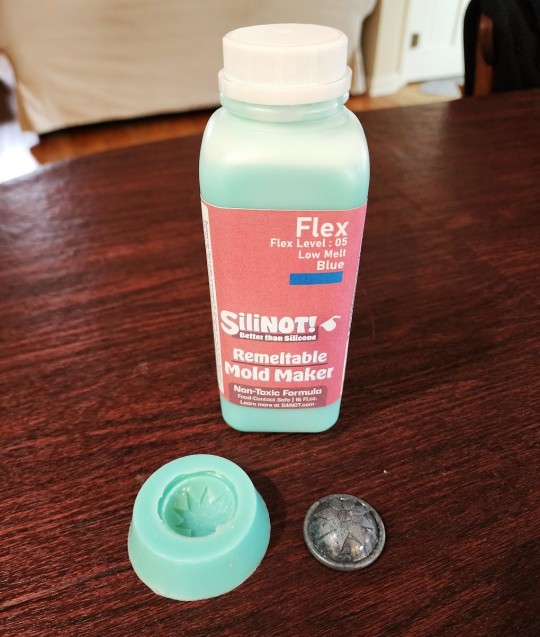
First, if you aren't familiar with this material, SiliNOT! is a remeltable, reusable medium for making molds. Though its exact ingredients are not disclosed, it purports to nontoxic, food-safe, and compostable. It melts in a household microwave or double boiler and solidifies at room temperature (or in a refrigerator/freezer for faster results). The website is https://silinot.com/.
(I am not an affiliate, and have no connection to this company apart from having made one retail purchase from them. I just have a lot of casting experience and like trying out new products.)
The Positive Original
I’m still in the middle of a Vincent Valentine build, so I decided to test the SiliNOT! on his custom buttons. My original is a stack of various nonporous materials: an antique (probably Bakelite) coat button, an epoxy resin dome I cast using a mold I already had in my library, and some engraved Worbla’s Pearly Art for the raised detail. The button shanks won’t be added until the final casting, so the original can be mounted flat for the moldmaking process.
Sample Worbla on the left; completed button stack on the right:
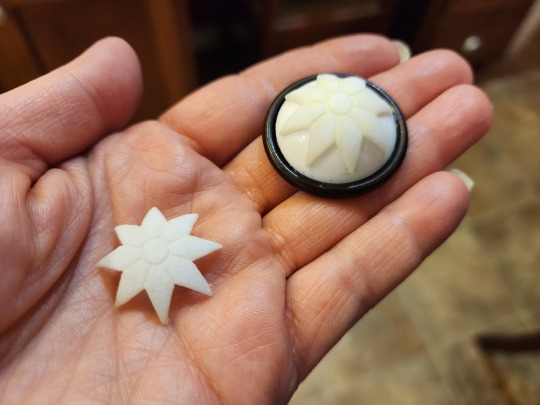
The Mold
I built the mold container the same way I do for silicone pours, with the flat back of the button fixed to a styrene plate and a cylinder (actually a small paper cup with the bottom cut off) surrounding it for the walls. The lip of the cup is sealed all the way around with Monster Clay to prevent leaks.
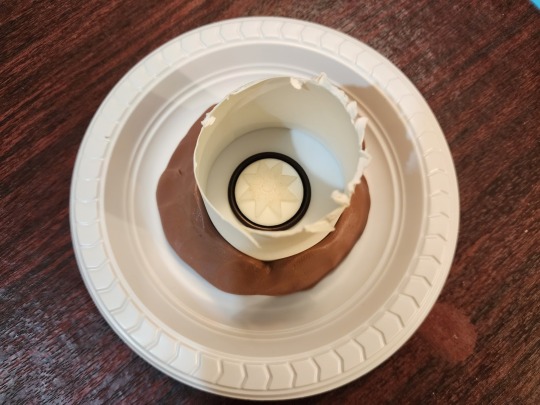
Heating and Pouring
The SiliNOT! didn’t take long at all to heat up; I did maybe four or five 20-second bursts before it was completely fluid. The bottle does get rather warm, so hand protection isn’t a bad idea. If you have heat-resistant gloves, you can use those; I was working in my kitchen (yay for nontoxic stuff!), so I just grabbed an oven mitt with a silicone grip.
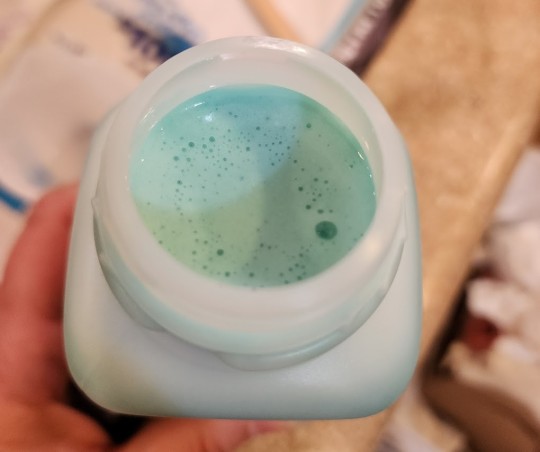
The melted SiliNOT! looks a bit like Luke Skywalker’s blue milk. It’s about the consistency of a yogurt smoothie and likes to pour in a thicker stream compared to silicone. While silicone can be stretched into a thin ribbon for delicate pours or chemically thinned with solvent for really tricky jobs, SiliNOT!'s viscosity is dependent on temperature and never seems to get quite as thin as silicone.
I’d automatically made my mold compact to conserve material (not really a concern with a reusable moldmaking material like SiliNOT!, but after using silicone for more than a decade, I’ve trained myself to be as efficient as possible), so the walls of my mold container were only about half or three quarters of an inch from my object. Because the target was so narrow, I found it difficult to accurately fill from the lowest area of the mold with the SiliNOT! The heavier pour also means more air can get trapped in or under the material.
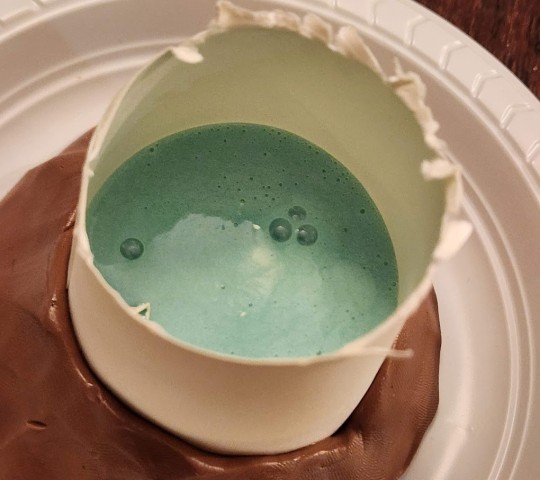
Bubbles are one of the areas in which SiliNOT! is decidedly inferior to silicone. SiliNOT! has higher viscosity, so bubbles don’t want to rise to the surface without vigorous tapping, which can distort the mold edges or affect leveling depending on your mold container. The bubbles that do make their way to the surface are difficult to pop, even when poked with a sharp implement. Heat gun degassing doesn’t have much effect.
Since the bubble surface cools and skins over quickly, I actually had to use a tool and scoop some large bubbles completely out of the mold to allow the surface to level. Critically, the SiliNOT! is opaque, so you can’t spot bubbles clinging to the surface of your original. (This is why my first mold was a reject, and I had to repour. More on that below.)
Hardening
Once the surface had set, I carefully moved the mold into the refrigerator to cool faster. Here’s another area where some types of silicone can have an advantage: I typically use fast-curing Smooth-On products (because I always have random quantities left to use up after our casting workshops), so I rarely have to wait more than half an hour for a silicone mold to cure, regardless of its size or mass.
The SiliNOT! has to chill completely before handling, though, and discharging that amount of heat requires a fair amount of time even in a cool environment. My mold was pretty small, maybe 2 1/2” wide by 1” deep, and it still took around 40 minutes to cool completely. A larger, deeper mold could hold considerably more energy in the center, and might have to be left in the freezer for a couple of hours before use.
Demolding the Original
When the mold was completely chilled, I removed it from the refrigerator and popped it off the plastic plate I’d used for the base of the mold. The texture was very different from what I’d expected: Unlike other meltable materials (Monster Clay, et al.) that have a firm surface when cool, the SiliNOT! remains tacky, which means it promptly collects any debris that crosses its path. In my case, this meant I had to pick dog hair off the surface throughout the casting process (and I don’t want to think about what would happen if glitter had contaminated the work space).
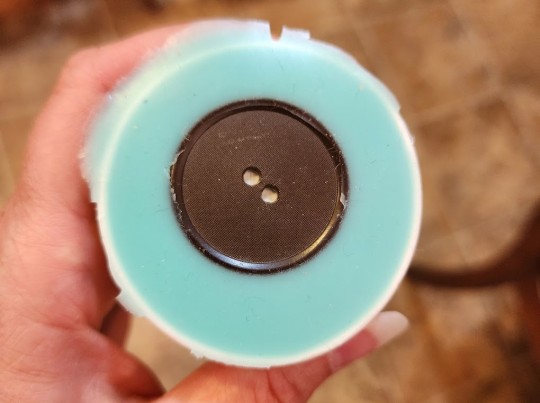
I’d used a paper cup for my mold walls, which usually works fine with fast-curing silicone. But the SiliNOT! must have a high oil content, because the cup absorbed some of it:
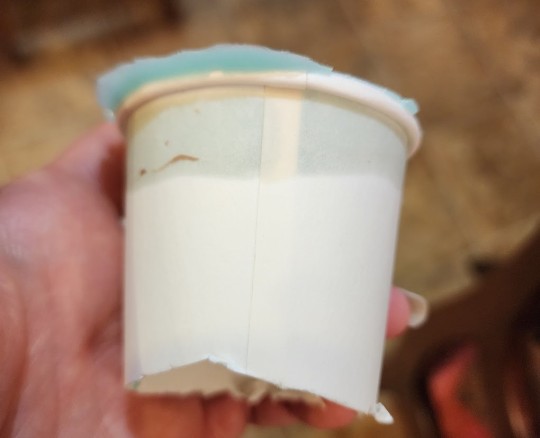
Lesson learned; use only nonporous containers with this stuff.
The SiliNOT!! really wanted to cling to the edges of my original, so I had to go slow at first to avoid tearing the thin flanges of the mold off. However, it did demold nicely from the smooth surfaces, and preserved texture very well. You can see the Worbla pebbling and the engraving channels clearly in the mold (as well as some dust and dog hair, because I made the mistake of setting it down briefly):
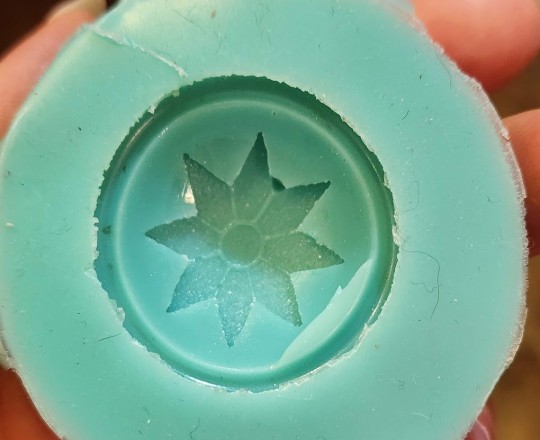
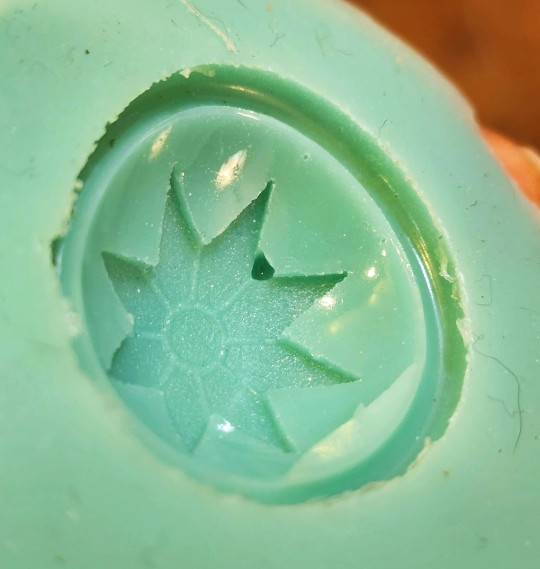
Unfortunately, as you can see, a large bubble had stuck to my original and created a pit in the mold, so I decided to do a second mold pour. I figured I’d tear up the failed mold and put the pieces back in the bottle to remelt… and discovered I couldn’t. The mold would stretch and twist, but not tear. It also seemed to return to its original shape relatively faithfully. Here’s a video of me manhandling the mold:
As you can see, the SiliNOT! has much better stretch and recovery than many silicone products (there are silicones that stretch well -- some of the Dragon Skin products come to mind -- but they’re not typically marketed for moldmaking). This means it’s likely well suited to casting objects with moderate undercuts or oddly-shaped bits that need the mold to stretch during demolding.
You can cut the SiliNOT! easily with scissors, which is the recommended method for getting it back in the bottle when you’re ready to remelt.
Take Two
Using what I’d learned from the first pour, I did the second one inside a hard plastic ramekin. This gave me a bit more room to pour into the floor of the mold, reducing the bubble risk, and also eliminated the porous paper cup that had absorbed oil. I still had the issue with bubbles that didn’t want to pop, but there were fewer of them this time.
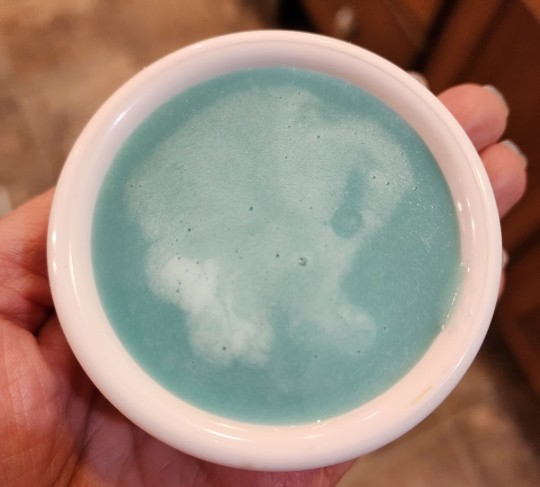
The ramekin made for a much cleaner mold, buuuuut there was ANOTHER BUBBLE right in the middle of the design. >.<

Take Three
Lather, rinse, repeat. Or in this case, melt, pour, chill.
This time I heated the SiliNOT! as much as I dared and did the absolute slowest, narrowest pour I could manage, giving the air extra time to escape as the mold was filled from the bottom. The risk with stringing out the pour like this is that in a thinner stream, the heat escapes faster, leading to uneven viscosity as the liquid fills the mold. I don’t think that’s a major problem for this particular piece, but it’s something to pay attention to as regards leveling and degassing, especially for larger molds that will take longer to fill.
The result of pour three:
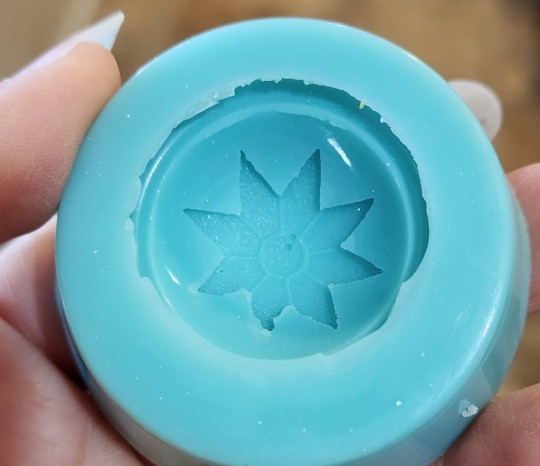
/siiiiigh/ Well, at least the bubbles are smaller, this time. They may not show up enough to matter in the final cast. I’ll give it a try.
Casting
I had leftover workshop resin that was getting on toward the end of its shelf life, so I used Smooth-On Smooth-Cast 300 for my initial resin trial. It’s an opaque white resin with about a 10-minute cure time (the fast turnaround is why we use it for workshops).
Before pouring, I had to do a little mold cleanup where the SiliNOT! had managed to sneak under the edge of the Worbla (I think I’d loosened the corner of the star from prying it out of so many molds), but since the SiliNOT! stretches so well, it was pretty easy to invert it to get little scissors down into the bottom of the depression.
For the first cast, I didn’t use anything but the resin in order to get a baseline. Ideally I’d like to cold cast or dye the resin so I don’t have to worry about paint chipping, but since I’m doing a trial here (and need multiple buttons anyway) I figured some plain white extras wouldn’t hurt.
So, my first cast…
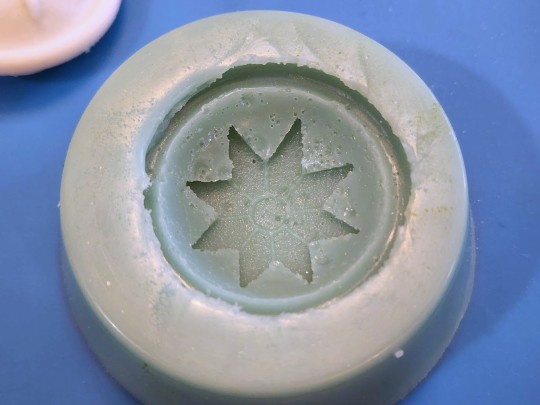
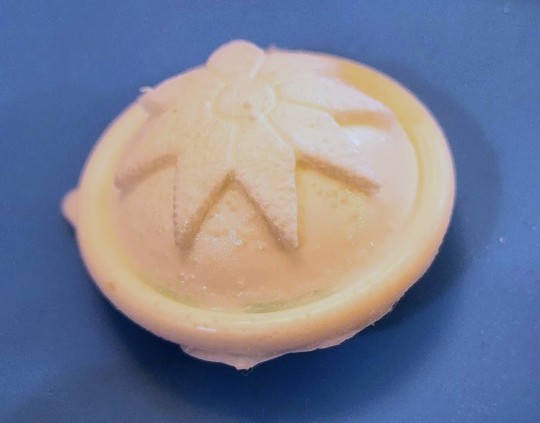
…smacked into a big problem, which I probably should have seen coming: The resin I’m using is a fast cure formula, which means it discharges a fair amount of heat as it's going through that rapid chemical reaction -- enough heat to melt the SiliNOT!, as it turned out. When I tried to demold it (after giving it a few extra minutes beyond label time to be sure it was done), the surface of the mold had melted to the resin and even embedded itself in a few places. It’s difficult to see the resin detail in the photos (my camera went into white balance panic mode with all the shades of white and blue), but you can see how pitted the formerly-smooth mold surface is.
In fairness to the SiliNOT!, the bottle does say that you should put the mold in the freezer for half an hour before casting high-temperature materials. But I assumed high-temperature material was something like candle wax or melted chocolate, rather than ordinary resin. (And the mold had just come out of the refrigerator.)
So, on to pour FOUR of the SiliNOT! mold…
Take Four
NGL, this is getting a little old. >.<
Fourth mold definitely needed some cleanup around the edges, and there are still a couple of tiny bubbles I can’t seem to get rid of, but it’s good enough for a test. (I’m starting to despair of using these for actual production, given how many times I’ve had to redo the molds because of bubbles...)
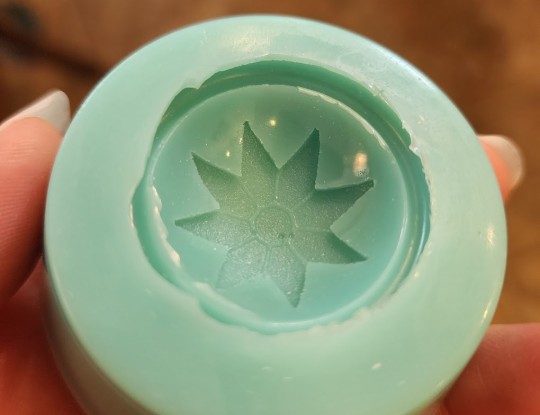
Deep in the recesses of my basement, I found some transparent epoxy resin with a 24-hour cure time -- much slower and lower-temperature than the Smooth-Cast. Since it cures clear, I went ahead and mixed in some metallic powder pigment on the off chance that I get a usable button out of this one. I had excess resin after mixing, so I poured that into my first mold, which has a bubble in the design but is otherwise fine. Two test pieces are better than one, right?
Results
Here are the results of the slow-curing resin out of mold #4:
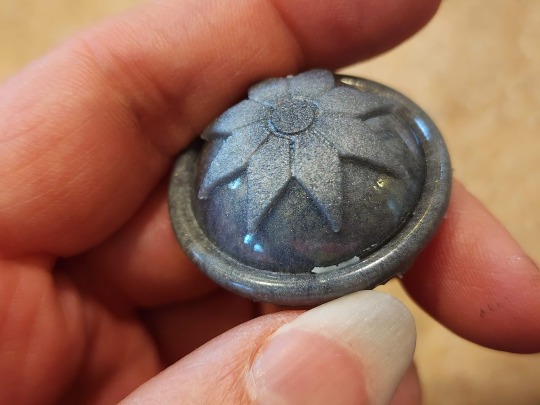
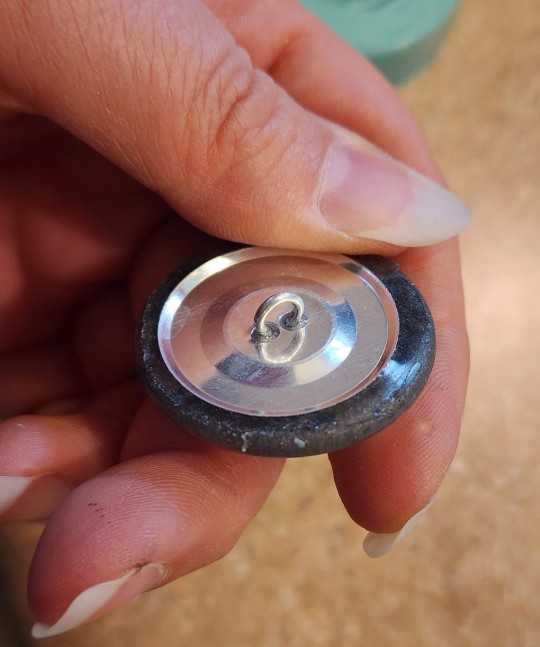
Finally, a (mostly) clean cast!
As you can see, the detail reproduction is excellent -- certainly on par with the pulls from the silicone mold I ended up making while waiting on this set to cure (purely for time reasons; I couldn’t afford five days to cast the buttons using slow-curing resin, and with a silicone mold and fast-curing resin I could get them all done within a couple of hours).
However, you can also see a few spots where bits of the SiliNOT! embedded themselves in the final cast. Part of that may be due to design flaw in the original; I didn’t want to glue anything permanently to the antique button, and that resulted in a tiny gap between the button and the resin hemisphere. Silicone has enough strength to resist tearing out in that kind of area, but apparently the SiliNOT! doesn’t. The bits of mold around the outer edge seem to have stuck just to be difficult, as there was no structural reason for those to have become embedded in the resin. This means the mold could be damaged by successive casts, reducing its usable life and accuracy.
Still, the mold definitely produced decent results for a first cast, and a different shape might not have had as much of a problem with tearing off mold parts. The slow-curing resin is a bit of a limitation, but not a unique one (I use this same epoxy resin for any glass-clear casts I do, and only use the Smooth-Cast 300 for opaque items or things I need very quickly). I don’t personally use UV resin, but I’d be curious to learn how it performs with the SiliNOT!
IN SUMMARY:
Here’s the TL;DR on SiliNOT!
Pros
Cost effectiveness. This is the most obvious advantage of SiliNOT! over silicone; it’s (theoretically) infinitely reusable, and even with natural attrition/inevitable contamination from use, you can likely get over a hundred pours out of a bottle. That's a lot cheaper per use than silicone.
Non-toxicity. SiliNOT! is touted as food contact-safe, so you don’t have to panic if you get it on your skin or kitchen counters. While platinum-cure silicone is also relatively harmless (some varieties are labeled for food or life casting), other common moldmaking materials such as tin-cure silicone or urethane are not. (NOTE: Since the company is very hush-hush about what actually makes up the SiliNOT! secret formula, I do not know if it might release any vapors or fumes that would be irritating or harmful to pet birds. In general, I advise not doing any kind of casting around birds.)
Eco-friendliness. This is the biggest draw for me personally: Given the number of casting workshops I run and all the things I sell commercially, I have constant guilt about the amount of waste I generate for creative projects. In most areas of life I’m an aggressive reduce/reuse/recycler and try to use organic materials instead of synthetics whenever possible, so a mold that’s reusable and compostable is very appealing.
Ease of use. It’s honestly pretty hard to mess this up -- just microwave according to the directions and pour. No measuring, no A/B mixture, no concerns about chemical contamination from latex or sulfur, etc.
Shelf life. Unlike silicones, which have a shelf life of anywhere from six months to three years depending on storage conditions, the SiliNOT! purports to be shelf-stable. It's compostable, so don’t bury it in your yard, but otherwise it appears that it could be kept on hand for years.
Cons
Bubbles. Honestly the most irritating thing about this stuff for me. I’m used to being able to see bubbles forming as I pour, tap them to the surface, and remove them. The fact that I poured four molds of the same object and never once got one without bubbles is super irritating.
Stickiness. I’m not a big fan of the tacky surface texture, and while I haven’t done any cold casting yet, I can imagine that it would be very difficult to clean out any pigment or mica powder that got where you didn’t want it. I probably wouldn’t use this for any kind of cold casting that required isolated colored areas or changing colors between casts.
Set time. The SiliNOT! may take longer to cool than a fast silicone would to cure when dealing with larger molds, so it’s not ideal for projects with a really tight turnaround. (But cosplayers would never be casting something the night before a con, right? We always plan ahead and never, ever procrastinate!)
Library life. The SiliNOT! may or may not structurally degrade over time the way urethane, latex, and tin cure silicones do, but I noticed even in my very limited casts that it was prone to having tiny bits of the mold (particularly at edges) stick and pull off. While I keep most of my platinum silicone molds for years and reuse them, I don’t feel that the SiliNOT! molds would hold up to repeated casting, and they’re far more sensitive to ambient temperature, so they’re probably best used for short term only. (I also wonder about the possibility of oil leaching out in long-term storage.)
Comparative Ranking
Ranking it against other mold-making materials, I’d place SiliNOT! below platinum-cure silicone in terms of performance, but maybe somewhere in the neighborhood of urethane and tin-cure silicone. It's definitely superior to latex. (Though to be honest, I'd rank Play-Doh above latex. I hate working with that stuff.)
Factoring in cost and environmental impact, it beats out urethane and tin-cure silicone. I'm still not sure if I'd rank it above platinum-cure silicone, though... Silicone costs much more and isn't eco-friendly, but the performance and lifespan is significantly better, so it still makes more sense for some projects.
Alginate is another type of material entirely, but in some ways SiliNOT! is comparable to it -- both are more cost-effective than silicone, both are biodegradable, both are skin safe, and both have long shelf lives. But SiliNOT! is easier to use for beginners than alginate, which has to be mixed to the right consistency and has an extremely short lifespan once poured.
Overall, I would recommend SiliNOT! for:
People who want accurate, non-shrinking molds but don’t have the budget for platinum-cure silicone
People who are committed to eliminating waste from single-use materials, and are willing to trade off a little performance for a more eco-friendly material
Projects with smooth surfaces and no indentations/sharp edges/undercuts where bubbles might stick (e.g. cabochons; simple geometric forms)
Projects where you need only one or two casts of something, rather than many casts from the same mold
Casting oddly-shaped pieces around which the mold needs to stretch in order to demold
Use with slow-curing resins that do not generate much heat
I would NOT recommend SiliNOT! for:
Extremely complex or detailed pieces, or pieces with a lot of surface texture that bubbles might stick to
Two-part molds
Projects requiring many identical casts out of the same mold
Molds that you intend to add to your library for future or repeat casting
Use with fast-curing resins, melted wax, melted Monster Clay, or any other material that emits heat
Cold casting with precise color application
My Overall Opinion
It's... okay? I will almost certainly keep SiliNOT! in my toolkit for certain specific applications. It's MUCH cheaper over the long term, I love the idea of recycling mold material, and there are some projects for which it will likely perform very well (those listed in the above bullet points). I will also admit that three days of working with it does not constitute a comprehensive familiarity with the product, and it might be the sort of thing that you get better at working with after more practice. (Just learning how to eliminate bubbles would go a long way toward making me adopt this for more projects!)
However, I don't quite buy the "better than silicone" tagline. It's definitely more difficult to get a perfect result, and there are some projects for which platinum-cure silicone is always going to be more reliable (e.g. high-temperature casting, mass production, large-scale life casting).
For those looking for a recommendation of whether or not to buy, I'd say look at your project budget and the applications for which you're going to be making molds, and let those factors guide which mold material you go with. People doing some kinds of projects are likely going to find this a godsend, while those doing different projects would probably hate working with it.
39 notes
·
View notes
Text
What is the Lifespan of Aluminum Residential Metal Roofing?
If you're a homeowner contemplating a roof replacement or simply looking to improve your home, you may be curious about the lifespan of aluminum residential metal roofing. Investing in a roof is a significant decision, and understanding how long your choice will last can help you make the right one. In this article, we will dive into the durability and longevity of aluminum residential metal roofing and why it might be the perfect choice for your home.
Understanding Residential Metal Roofing
Residential metal roofing is becoming increasingly popular among homeowners due to its impressive durability and long lifespan. Unlike traditional roofing materials such as asphalt shingles, which typically last 20-25 years, aluminum roofs can last 50 years or even longer. This is an attractive feature for many people who want to minimize the frequency of roof replacements.
In this article, we’ll explore the factors contributing to the longevity of aluminum residential metal roofing, the benefits of choosing this material, and how it can add value to your home.
Lifespan of Aluminum Residential Metal Roofing
So, how long can you expect aluminum residential metal roofing to last? With proper maintenance, aluminum roofs can last an average of 0 years. Their exceptional lifespan is due to several factors, including the material's inherent properties and manufacturing processes.
Corrosion Resistance
Aluminum is naturally corrosion-resistant, making it suitable for various climates, including areas with high humidity and salt exposure. This means that your roof is less likely to deteriorate over time due to environmental factors.
Durability Against the Elements
Aluminum roofing can withstand extreme weather conditions, including heavy rain, snow, and wind. This durability contributes to its longevity, as traditional roofs may succumb to the elements sooner.
Low Maintenance Requirements
Aluminum roofs are designed to be almost maintenance-free. They don’t crack, peel, or curl like other roofing materials and are e stan to algae and moss growth. Minimal upkeep means your roof will retain its integrity over the years.
Factors Affecting the Lifespan of Metal Roofing
While aluminum residential metal roofing generally boasts a long lifespan, several factors can influence how long your roof will last:
Quality of Installation: Having your roof installed by experienced professionals is crucial. Poor installation can lead to premature wear and issues like leaks.
Type of Coating: Many aluminum roofs have protective coatings that enhance longevity. These coatings can help resist corrosion and UV damage, extending the roof's life.
Climate and Environmental Conditions: Extreme weather, such as heavy snowfall or strong UV rays, can affect the longevity of your roof. However, aluminum is designed to withstand many of these challenges.
Maintenance Practices: Regular inspections and maintenance can greatly extend the lifespan of your roof. Keeping gutters clean and ensuring no debris accumulates can help mitigate potential issues.
Benefits of Aluminum Residential Metal Roofing
Investing in aluminum residential metal roofing comes with many benefits beyond just longevity. Here are several reasons why homeowners are choosing this roofing material:
Energy Efficiency
Aluminum roofs reflect heat away from your home, reducing cooling costs by up to 25%. This energy efficiency leads to reduced bills and a more comfortable living environment.
Eco-Friendly
Aluminum is 100% recyclable, making it an environmentally friendly choice. When replacing your roof, the material can be recycled, reducing waste and promoting sustainability.
Aesthetic Appeal
Aluminum roofs come in various colors and styles, allowing homeowners to choose a look that complements their home’s exterior. Whether you prefer a traditional or modern appearance, there are options to match your vision.
Increased Home Value
A metal roof can increase a home’s resale value by up to 6%. Potential buyers often consider a durable roofing material a significant advantage, making a home more appealing.
Is Aluminum Residential Metal Roofing Right for You?
When considering a new roof, weighing the pros and cons of different materials is essential. Aluminum residential metal roofing offers an impressive lifespan, durability, and energy efficiency, making it a compelling choice for many homeowners. If you're looking for a long-term solution that can withstand various weather conditions.
Invest in Lasting Protection
In summary, aluminum residential metal roofing can last 50 to 70 years, depending on installation quality, environmental conditions, and maintenance efforts. With its corrosion resistance, low maintenance requirements, and energy efficiency, aluminum roofs are an excellent option for homeowners seeking durability and longevity.
Are you ready to enhance your home with a roofing solution that offers lasting protection and style? Visit Lastime Exteriors today to explore our services and learn more about energy-efficient roofing solutions that fit your needs!
7 notes
·
View notes
Text
Blog #5- Understanding and Addressing Climate Change
Hi everyone,
Welcome to my week 5 blog post!
This week, I will explore the significant impacts of climate change on our planet and its effects on ecosystems, biodiversity, and the future of life on Earth.
What is climate change?
Climate change refers to long-term shifts in temperatures and weather patterns. These changes can be natural, such as those caused by volcanic eruptions or they can be human-driven, primarily due to burning fossil fuels. According to the United Nations, since the 1800s, human activity has been the main driver behind the effects of climate change. You may wonder why burning fossil fuels has such a significant impact on our Earth. Burning fossil fuels generates greenhouse gas emissions, which trap the sun's heat and lead to rising global temperatures. Carbon dioxide is the most abundant greenhouse gas emitted by human activity. Sources of these emissions include energy production (such as burning oil, coal, and gas), agriculture, and transportation.

Fun Fact: Did you know that CO2 emissions are the highest they have ever been in the past 2 million years, reaching 420 parts per million (ppm)?
Climate Change and Its Impact on the Earth
Climate change is an ongoing issue that affects our planet in numerous ways. The increased levels of greenhouse gases lead to more frequent and intense weather events, such as storms, floods, extreme heat, droughts, severe cold, and heavy snowfall. Additionally, we are witnessing the effects of ocean acidification as the oceans absorb more carbon dioxide from the atmosphere, resulting in a drop in pH and putting marine life at risk. You may have noticed these changes in your area. I remember when I was younger, we used to experience much more snow than we do now in the winter!
Climate Change's Impact on Wildlife
Climate change has a significant impact on wildlife threatening many species around the world. Rising temperatures alter vegetation and food sources, forcing animals to migrate beyond their native habitats in search of more suitable conditions. This increases the risk of extinction for many species. Additionally, the growing intensity of extreme weather events has led to significant habitat destruction and loss of life among wildlife populations.
One species that is severely affected by climate change is the polar bear. These animals depend on sea ice for mating, resting and hunting for seals, their primary food source. However, as arctic temperatures rise and ice continues to melt, polar bears must travel greater distances to find food, leading to malnutrition and low reproduction rates.
Scientists predict that by 2050, two-thirds of the world's polar bear population could disappear.

Graph of changes in arctic sea ice over time
What Can We Do to Help?
There are many ways to reduce your carbon footprint and protect our future and our planet's future:
- Use public transit - Carpool - Bike or walk for shorter trips - Recycle and compost - Choose sustainable brands - Planting trees - Use renewable energy
In some cases, it can be difficult to reduce our carbon footprint. Some people may be unable to make specific changes, so it's important to recognize that. For example, if you work far from home, you might need to drive your car to work every day. Switching to solar, wind, or hydropower can be costly and unrealistic for some families. However, small actions, such as recycling, composting, minimizing waste, and choosing more eco-friendly brands, can also be just as effective in reducing our carbon footprint.
Questions for further discussion:
What was the most interesting thing you learned from my post?
What actions would you take to mitigate climate change?
Thanks for reading!
Biona🦋🌸🐻❄️
References: Ayesha Tandon, R. P. (2022, December 8). Polar bears and climate change: What does the science say?. Carbon Brief. https://interactive.carbonbrief.org/polar-bears-climate-change-what-does-science-say/index.html
United Nations. What is climate change?. United Nations. https://www.un.org/en/climatechange/what-is-climate-change
Ocean acidification | National Oceanic and Atmospheric Administration. (2020, April 1). https://www.noaa.gov/education/resource-collections/ocean-coasts/ocean-acidification
9 notes
·
View notes
Text
Can Retractable Awnings Be Added to a Sunroom?
Are you looking to enhance your sunroom experience? If so, you might be wondering if retractable awnings can be integrated into your cozy outdoor retreat. Imagine enjoying the beautiful sunlight during the day while having the option to provide shade when the sun gets too intense. In this article, we’ll explore how retractable awnings can complement your sunroom, providing functionality and style to your outdoor living space.
Understanding Sunrooms
Sunrooms have become a popular choice for homeowners seeking to blend the beauty of the outdoors with the comforts of indoor living. Whether you have a screen room, three-season room, or a fully insulated four-season room, adding a sunroom allows you to enjoy the sights and sounds of nature without the typical nuisances like bugs or unpredictable weather. But did you know that adding retractable awnings can further enhance this experience?
The Benefits of Retractable Awnings
1. Versatility in Shade Control
One of the biggest advantages of retractable awnings is the ability to control the amount of sunlight entering your sunroom. On bright, sunny days, simply extend the awning to provide shade and keep the interior cool. When you want to soak in the sunlight, retract the awning with ease. This flexibility can make your sunroom more comfortable throughout the day.
2. Enhanced Energy Efficiency
By providing shade during peak sunlight hours, retractable awnings can help reduce the amount of heat that enters your sunroom. This not only keeps the space more comfortable but can also lower your energy costs. A cooler sunroom means less reliance on air conditioning, making it an eco-friendly choice.
3. Protection from Weather Elements
While sunrooms offer shelter from many elements, retractable awnings provide an additional layer of protection from rain and wind. You can enjoy your outdoor space even when the weather isn’t perfect by extending the awning to shield against light showers. This means more days spent enjoying your favorite leisure activities without worrying about the weather.
4. Style and Customization
Retractable awnings come in a variety of styles, colors, and patterns, allowing you to customize the look of your sunroom. This can enhance the overall aesthetic of your home, making it more inviting and visually appealing. Choose an awning that complements your sunroom design to create a cohesive outdoor living space.
Sunroom Types and Awning Compatibility
Screen Rooms
For those with screen rooms, adding retractable awnings can help manage sunlight while still enjoying the natural breeze. The mesh of the screen allows for airflow, and the awnings can provide a comfortable shaded area for lounging.
Three-Season Rooms
If your sunroom is a three-season room, retractable awnings can be a perfect addition. They protect from harsh sunlight during the day, making the space more enjoyable for relaxation or entertaining guests.
Four-Season Rooms
Four-season rooms are designed for year-round use, and incorporating retractable awnings can enhance your comfort during the warmer months. They help mitigate heat build-up and can add an extra layer of insulation when closed.
Installation Considerations
If you decide to add retractable awnings to your sunroom, there are a few factors to consider during installation:
Frame Compatibility: Ensure that the awning frame is compatible with your sunroom’s structure, whether it’s aluminum, wood, or another material. Professional installation can help guarantee a secure fit.
Awning Size: Measure the dimensions of your sunroom to determine the appropriate size for your awning. Awnings come in various widths and projections, so choose one that fits your space perfectly.
Motorized vs. Manual Operation: Consider whether you prefer a manual or motorized retractable awning. Motorized options can be conveniently controlled with a remote or wall switch, while manual options may require a bit more effort to operate.
Maintenance Tips for Retractable Awnings
To ensure that your retractable awnings remain in good condition and function effectively:
Regular Cleaning: Clean the awning fabric regularly to remove dirt and debris. Most fabrics can be hosed off or wiped down with mild soap and water.
Inspect Mechanisms: Periodically check the mechanical parts of the awning, such as the pulleys and brackets, to ensure they are functioning smoothly.
Seasonal Care: If you live in an area with harsh winters, consider retracting the awning during snow or ice conditions to prevent damage.
Conclusion
Adding retractable awnings to your sunroom can elevate your outdoor living experience. They provide versatile shade control, improved energy efficiency, and enhanced protection from weather elements, all while adding style to your space. Whether you want to enjoy a cozy reading nook bathed in soft light or a lively gathering spot shielded from direct sun, retractable awnings are a great addition.
If you’re ready to create a sunroom that perfectly suits your lifestyle, explore Screenmobile’s custom sunroom solutions. Our designs offer year-round comfort, weather protection, and the potential to increase your home’s value. Visit Screenmobile today for a consultation and discover how we can help you create the perfect outdoor living space tailored to your needs. Embrace the beauty of the outdoors in comfort and style!
2 notes
·
View notes
Text
Why Clay Roofs Are the Perfect Choice for Homes in Delhi
In the ever-evolving world of architecture and construction, homeowners in Delhi are seeking roofing solutions that not only enhance the visual appeal of their properties but also provide long-lasting durability and sustainability. One such timeless and eco-friendly solution gaining popularity across residential and commercial projects is the clay roof.
What is a Clay Roof?
Clay roofs are crafted using natural terracotta clay, molded and fired to produce durable roofing tiles. These tiles come in a variety of textures, shapes, and earthy tones, offering a rustic charm and traditional aesthetic that seamlessly complements both heritage and modern architecture.
Benefits of Installing a Clay Roof in Delhi
Weather Resistance: Delhi experiences extreme weather conditions—scorching summers, monsoon rains, and cold winters. Clay tiles are naturally resistant to high temperatures and UV radiation, and their dense structure makes them highly water-resistant, protecting the structure beneath.
Energy Efficiency: Clay roofs provide excellent insulation, keeping homes cooler in summer and warmer in winter. This helps reduce energy bills by minimizing the need for artificial cooling or heating systems.
Eco-Friendly & Sustainable: Made from natural materials, clay roofing tiles are recyclable, non-toxic, and have a low environmental impact during production and disposal.
Longevity: Clay roofing can last for more than 50 years with minimal maintenance. Their strength and ability to resist mold, rot, and insects make them a cost-effective, long-term investment.
Aesthetic Appeal: With their rich, earthy tones and classic appeal, clay tiles can elevate the overall appearance of any structure. They pair beautifully with both traditional Indian homes and contemporary designs.
Ideal Applications
Clay roofs are widely used in villas, heritage buildings, bungalows, resorts, and even commercial properties seeking a classic aesthetic. In Delhi, areas with colonial architecture or modern eco-conscious designs are increasingly turning to clay tile solutions.
Why Choose Blooms India for Clay Roofing?
At Blooms India, we offer a curated range of premium clay roofing tiles that combine traditional craftsmanship with modern technology. Our clay roof solutions are known for their durability, beauty, and performance in extreme weather.
Our team ensures expert installation, high-quality materials, and customer satisfaction at every step of the process.
For more information, please visit: 👉 https://www.bloomsindia.net/cladding.html
#clay roof in delhi#terracotta roof tiles#eco-friendly roofing#clay tile installation#roof cladding delhi#sustainable roofing#traditional roofing solutions#clay roofing tiles supplier#delhi roofing contractors
2 notes
·
View notes
Text
Why Commercial Roof Restoration is Key to Protecting Your Business

When it comes to making your commercial building durable, one of the most neglected parts tends to be the roof. However, roof restoration is a basic service that can not only make your roof durable but even save you hundreds of dollars in the future. Commercial roof restoration is a cheap choice in comparison to an entire roof replacement and contains a whole lot of benefits to provide to businesses.
To begin with, commercial roof restoration avoids water damage that can be incurred. Roofs can leak due to wear and tear over the years, which can lead to costly repairs or even interior damage. By restoring your roof, you get to repair issues like cracks, broken seams, and leaks before they become major issues. This costs much less than waiting for damage to be widespread.
Another main advantage of roof restoration is improved energy efficiency. The majority of commercial roofs have reflective coatings that reduce heat absorption, decreasing the temperature of your building during the warmer months. This can mean less money spent on energy bills and a more comfortable working environment for both clients and employees. A sound roof in good condition can also improve your building's overall insulation, once more reducing the need for HVAC usage.
Roof restoration also extends the life of your roof by a number of years. Instead of undergoing the costly and disruptive process of a full roof replacement, restoration allows you to restore the existing roofing system, upgrading its performance and longevity. In this way, you can avoid the hassle of construction work and keep your business running as usual.
Finally, roof restoration is an eco-friendly choice. By restoring rather than replacing your roof, you avoid waste and help promote sustainability. Most roofing materials utilized in restorations are environmentally friendly, so you can feel good about making a decision that is good for your business and good for the planet.
In conclusion, commercial roof restoration is a valuable investment. It spares your business expensive repairs, enhances energy efficiency, and enables you to possess a sustainable building. If your roof is showing signs of degradation, do not wait for a disaster to strike—contact a professional roofing contractor to discuss your restoration options today!
2 notes
·
View notes
Text
Protecting Your Home Investment with Durable Roofs During Storm Season
Introduction
When it comes to safeguarding your home, few things are as critical as a sturdy roof. Protecting your home investment with durable roofs during storm season isn’t just a good idea; it’s essential for maintaining the safety and integrity of your property. Storms can wreak havoc, and if your roofing materials aren’t up to par, you may find yourself facing costly repairs or worse. In this article, we’ll delve into the world of roofing—specifically focusing on roofing materials in Cork, durable roofs in Cork, and the various types of weather-resistant solutions available.
So grab a cup of coffee, sit back, and let’s explore how to keep your home safe from the elements.
Understanding Weather-Resistant Roofing What is Weather-Resistant Roofing?
Weather-resistant roofing refers to materials designed to withstand adverse weather conditions such as heavy rain, strong winds, hail, and even snow. These roofing types are engineered to prevent leaks and damage during storms, ensuring that your home remains dry https://about.me/rooferscorkcity/ and comfortable.
Why Choose Weather-Resistant Roofing in Cork?
In Cork, we’re no strangers to unpredictable weather. The right roofing material can mean the difference between a cozy home and a leaky nightmare. Choosing durable roofs in Cork can save you time, money, and stress down the line.
Types of Durable Roofs for Storm Season Asphalt Shingles: The Popular Choice
Asphalt shingles are one of the most common roofing types due to their affordability and durability. They come in various styles and colors but primarily offer decent resistance against wind and water.
Metal Roofing: A Tough Contender
Metal roofs have gained popularity for their longevity and ability to withstand extreme weather conditions. With proper installation, they can last over 50 years!
Slate Roofs: Timeless Elegance
Slate is not only stunning but also incredibly durable against storm damage. It's fire-resistant too! However, it tends to be pricier than other options.
Tile Roofs: A Mediterranean Look
Tile roofs are aesthetically pleasing while offering great durability against severe weather elements. They’re made from clay or concrete and can last for decades if maintained well.
youtube
Choosing Roofing Materials in Cork Factors to Consider When Selecting Roofing Materials Climate: Are you in an area prone to heavy rains or high winds? Budget: How much are you willing to invest? Longevity: Do you want something that lasts decades or something more temporary?
These factors will significantly influence your choice of roofing materials.
Roof Insulation in Cork Why is Roof Insulation Important?
Insulating your roof is vital for energy efficiency. Proper insulation keeps heat inside during winter months while preventing excess heat during summer—making it a smart investment.
Types of Roof Insulation Available
Cork insulation is gaining traction due to its eco-friendliness and excellent thermal performance. Other options include fiberglass batts and spray foam insulation.
Maintaining Your Durable Roof
2 notes
·
View notes
Text
Does Sustainability Go Hand in Hand with Technology and the Global Shift to Electric Power?
Explore how Sustainability Next to Technology is Connected to Global Move Towards Electric Power.
The new generation of moving the world towards cleaner energy has electric power at the core of this transformation.
But do they, sustainability and technology, indeed go hand in hand?
Well, it’s no longer a hypothetical question, but a problem that determines the future path of power distribution and energy management.
Growing Demand for Sustainable Solutions:
Not long ago, the dream of electric power turned into a reality before you know it.
Cleaner has become a key aspiration of governments, industries, and consumers alike.
Sustainability imparts a different meaning to reducing carbon footprints.
This also means making power systems smarter and less dangerous, more efficient, cost-effective, and probably even creating a bit of redundancy.
This will mean purchasing components for the switchgear industry that reduce energy waste, extend life cycles, and facilitate the interfacing of renewable sources.
Energy-efficient circuit breakers, digital monitoring systems, modular switchgear components, and other accessories are becoming key players in the evolution.
Smart Technology: The Backbone of Sustainable Switchgear
The way the whole change in switchgear technology moves is, of course, toward modernization.
IoT-type embedded devices for monitoring, AI-driven prediction of maintenance needs, and design for energy-efficient low-voltage contactors all transform the way the whole power is managed.
It ensures reduced energy losses and very much optimized peak condition behavior, as well as improved safety-all these fulfilling both sustainability and day-to-day operating efficiency objectives.
1. Digital Monitoring and Automation
It is all about real-time data.
Smart monitoring solutions provide instant access to information regarding the efficiency of the use of electricity, fault detection, and energy efficiency.
With this, downtime and failures incurred can be minimized, and energy consumption can be optimized-thus, saving unnecessary wastages of electricity.
2. Modular and Recyclable Components
Energy efficiency doesn’t only mean sustainability as far as power is concerned-it also has to do with waste.
Adaptive switchgear designs allow easy upgrades and replacements, which can prolong the life cycle of an electrical system while simultaneously reducing the amount of waste made for materials.
Adoption of recyclable and non-toxic materials in accessories for switchgear also minimizes environmental impact.
3. Energy-Efficient Contactors and Circuit Breakers
New advanced low-loss contactor and circuit breaker technologies, which increase energy efficiency, cut down heat dissipation and losses in the circuits.
Fewer losses in energy mean low operating costs and a reduced carbon footprint; these are the two main factors that are becoming crucial for today’s modern companies striving to meet sustainability goals.
Switchgear Accessories to Play a Critical Role in the Green Revolution
It is only through highly competent switchgear accessories that a truly sustainable power infrastructure may be realized: from low-voltage surge protectors that ensure a longer life for the system to biodegradable insulation materials, the right kind of components would all play their part in making a difference.
Eco friendly insulation: Using sustainable materials in insulation applications reduces the negative impacts on the environment while maintaining the safety and efficiency associated with conventional insulation types.
Adaptive Protection Relays: These help to ensure the stability of power and eliminate the breakdowns, thus eliminating the costs of frequent replacement and repairs.
Using Busbar Systems to Reduce Energy Losses: The more efficient a conductor is, the less its resistance and heat loss, and the better it transmits energy.
Balancing Innovation and Cost with Performance
In fact, the passage from several manufacturers and traders is the perception that sustainability involves more costs.
But in reality, such first costs are outweighed by very many long-term benefits.
The merger of lower maintenance costs, lower periodicity recall for new replacement pieces, and greater shelf life compliance does make sustainable switchgear a smart business choice.
Conclusion: The Future of Sustainable Energy
Technology and sustainability aren’t separate paths any longer; they’re bearing down more on a linear convergence as the world flows into a different shape concerning energy.
Change is a space that we all own.
The future is here-now!
6 notes
·
View notes
Text
💧 Glow Naturally: Unlock the Power of Pure Castor Oil with Pretty Farm Girl 🌿
In a world brimming with synthetic beauty and wellness products, there’s something truly refreshing about going back to nature. One timeless remedy that continues to capture hearts and heal bodies is organic castor oil—a rich, golden oil packed with nutrients and age-old benefits.

At Pretty Farm Girl, we bring you more than just oil. We bring you the best castor oil for holistic beauty and wellness—ethically sourced, cold-pressed, and 100% pure. 💚
Let’s explore why this versatile oil deserves a spot in your daily routine, how to use a castor oil pack for liver detox, and exactly where to buy castor oil you can trust.
Whether you're a wellness enthusiast or someone seeking natural solutions for beauty, detox, and self-care, this guide will cover everything you need to know about pure castor oil, where to buy it, and how to use a castor oil pack for liver detox. Let’s dive in! 💧
🌱 What is Organic Castor Oil?
Organic castor oil is extracted from the seeds of the Ricinus communis plant, native to tropical regions. This oil is rich in ricinoleic acid, a fatty acid known for its anti-inflammatory, antimicrobial, and moisturizing properties. 💫
Unlike refined oils, organic and cold-pressed castor oil retains all the nutrients and healing properties because it’s extracted without heat or chemicals. At Pretty Farm Girl, we ensure that our castor oil is:
✔️ 100% organic✔️ Hexane-free✔️ Cold-pressed✔️ Cruelty-free✔️ Packed in eco-friendly bottles
🌼 Nature’s golden gift in every drop.
💎 Why Pretty Farm Girl Offers the Best Castor Oil
With so many options available in the market, you might wonder: what makes Pretty Farm Girl the go-to for the best castor oil?
Here’s why our customers keep coming back:
⭐ Premium Quality
Our castor oil is certified organic and sourced from sustainable farms. We focus on purity and potency, ensuring you get the full benefits of nature’s most versatile oil.
⭐ Versatility
You can use our pure castor oil for:
🌿 Hair growth & scalp health
🌿 Eyebrow & eyelash thickening
🌿 Skin hydration & acne care
🌿 Natural laxative & digestive support
🌿 Liver detox with castor oil packs
⭐ Safe for Everyone
No parabens, no GMOs, and absolutely no synthetic ingredients. Just pure goodness, just how nature intended. 🕊️
🛍️ Where to Buy Castor Oil (That You Can Trust)
Looking for where to buy castor oil that’s authentic and organic? You’ve come to the right place.
💖 Pretty Farm Girl makes it super easy:
🛒 Shop directly from our official website 📦 Enjoy fast & eco-conscious shipping 🧴 Comes in spill-proof, UV-protected bottles
Avoid diluted or synthetic options from unreliable sources. With Pretty Farm Girl, you’re guaranteed pure castor oil with real results. 🌾

💆♀️ How to Use Castor Oil for Beauty 🌸
🌿 For Hair Growth
Massage a few drops of organic castor oil into your scalp 2–3 times a week. Leave overnight and wash with a mild shampoo. It promotes thicker, healthier hair and reduces dandruff. 💁♀️
🌿 For Eyebrows & Eyelashes
Dip a clean spoolie brush into pure castor oil and apply it to your lashes and brows before bedtime. Results show in 2–4 weeks! 👁️✨
🌿 For Glowing Skin
Use it as a night oil or mix a few drops with your daily moisturizer. Rich in fatty acids, it helps fade scars, hydrate dry patches, and calm irritated skin. 🌼
🍃 The Power of Castor Oil Pack for Liver Detox
One of the lesser-known yet powerful uses of castor oil is for liver detox. Using a castor oil pack for liver can help improve circulation, reduce inflammation, and support your body’s natural detox processes.
🧴 How to Make a Castor Oil Pack:
You’ll Need:
Pretty Farm Girl pure castor oil
A piece of organic cotton or wool flannel
Plastic wrap or a towel
A heating pad or hot water bottle
🔄 Instructions:
Soak the flannel in organic castor oil until saturated but not dripping.
Place the flannel over your liver (right side of your abdomen).
Cover with plastic wrap and then apply a heating pad.
Lie down and relax for 30–60 minutes.
Clean the area with a warm damp cloth afterward.
🌙 Use 2–3 times a week for a gentle, natural detox.
🧪 Science-Backed Benefits of Castor Oil
Studies and holistic health practitioners alike support the effectiveness of castor oil for:
🔬 Reducing inflammation🔬 Boosting lymphatic circulation🔬 Relieving constipation naturally🔬 Enhancing hair follicle health🔬 Balancing hormones when used over reproductive organs
When choosing where to buy castor oil, don’t compromise on quality. Pretty Farm Girl ensures farm-to-bottle freshness, backed by both tradition and science. 🧬🌾
💡 Pro Tips for Using Castor Oil
✨ Always perform a patch test before full application. ✨ Store in a cool, dark place to preserve potency. ✨ Use a glass dropper for mess-free application. ✨ Combine with essential oils like lavender or tea tree for added benefits.
🌍 Pretty Farm Girl Promise 🌻
We’re more than just a brand—we’re a movement. Pretty Farm Girl was born from a belief that natural wellness should be accessible, ethical, and empowering. Every bottle of our organic castor oil reflects our mission:
🌱 Clean Beauty 🌿 Sustainable Living 💚 Honest Ingredients
By choosing us, you're not only choosing the best castor oil—you’re joining a community that values self-care, slow living, and sustainable choices.
📣 What Our Customers Say
"I’ve tried many brands, but Pretty Farm Girl's castor oil is the purest I’ve ever used. My hair is fuller and my digestion is better!" — ✨Elena R.
"I started using the castor oil pack for liver twice a week and feel less bloated and more energized. Highly recommend!" — 🌟Maria G.
"Finally found where to buy castor oil that’s actually organic and effective. Lifesaver for my skin and hair!" — 💛Tasha L.
🎁 Ready to Try Pretty Farm Girl Organic Castor Oil?
There’s never been a better time to embrace the natural power of castor oil. Whether you're looking for a castor oil pack for liver, a natural hair growth remedy, or a skin elixir, Pretty Farm Girl has you covered. 💧
✅ 100% Organic ✅ Eco-Friendly ✅ Woman-Owned & Operated ✅ Available Online Now
👉 Visit PrettyFarmGirl.com to shop the best castor oil today and start your journey toward radiant wellness. 🌿💖

📌 Final Thoughts
Organic castor oil is more than just an old folk remedy—it's a modern must-have for clean beauty and holistic health. When you choose Pretty Farm Girl, you're investing in pure castor oil that's responsibly sourced, beautifully packaged, and designed with your wellness in mind.
So if you're still wondering where to buy castor oil, look no further. Join the growing family of natural beauty lovers who trust Pretty Farm Girl to deliver results—naturally. 🌼🌍
2 notes
·
View notes
Text
"Everything You Need to Know About Thermal Paper: A Guide by Parthivi Labels and Paper"
Welcome to the ultimate guide to thermal paper, brought to you by Parthivi Labels and Paper! Whether you're a business owner, a printer, or someone interested in the world of labels and receipts, thermal paper plays an important role in many industries. Let’s dive into what thermal paper is, its uses, and why choosing the right type of thermal paper is essential for your business.
What is Thermal Paper?
Thermal paper is a special type of paper that is coated with a chemical layer that changes color when exposed to heat. Unlike regular paper, thermal paper doesn't require ink or toner for printing. Instead, a thermal printer applies heat to the surface of the paper, causing it to react and form the text or images.
Thermal paper is commonly used in receipt printers, barcode labels, and point of sale (POS) systems due to its convenience and cost-effectiveness.
Types of Thermal Paper
At Parthivi Labels and Paper, we offer a variety of thermal paper products to meet the diverse needs of our clients. Here's a breakdown of the different types of thermal paper:
Standard Thermal Paper
Used in most receipt printers and POS systems.
Ideal for short-term use as it tends to fade over time when exposed to light or heat.
Top coated Thermal Paper
Has an additional coating to protect the print from fading.
Ideal for applications that require longer-lasting prints like shipping labels and tickets.
Black Thermal Paper
Features a black color as opposed to the standard white or cream.
Often used in specialty printing like high-end tickets or custom receipts.
Eco-friendly Thermal Paper
Coated without harmful chemicals like BPA.
A great option for businesses aiming to reduce their environmental impact.
Why is Thermal Paper So Popular?
Thermal paper is widely used in various industries for several reasons:
Efficiency: Thermal printers are fast and require no ink, making them cheaper to maintain.
Cost-Effective: The simplicity of thermal printing cuts down on the costs of ink cartridges, toners, and ribbons.
Durability: Thermal paper prints are resistant to smudging, and the print quality remains clear under normal use (though it can fade if exposed to excessive light or heat).
Space-Saving: With no ink or toner cartridges, thermal printers are often more compact, making them ideal for smaller spaces.
How Does Thermal Paperwork?
Thermal paper has a special heat-sensitive coating that reacts when exposed to the heat generated by a thermal printer’s print head. As the print head heats up specific areas of the paper, the chemicals in the coating turn black, creating the printed image or text.
Tips for Choosing the Right Thermal Paper
When selecting thermal paper for your business, it's important to consider the following factors:
Printer Compatibility: Ensure that the thermal paper rolls fit your printer’s specifications (e.g., size, diameter).
Print Duration: If you need prints that last longer, opt for top-coated thermal paper or eco-friendly options.
Environmental Considerations: Look for BPA-free thermal paper if sustainability is important to your business.
At Parthivi Labels and Paper, we specialize in high-quality, BPA-free thermal paper options that are perfect for businesses aiming to reduce their environmental footprint without compromising quality.
How to Store Thermal Paper
Proper storage is essential to maintain the quality of your thermal paper. To keep your paper in the best condition:
Store rolls in a cool, dry place away from direct sunlight, heat, and moisture.
Avoid exposure to chemicals like cleaning agents or oils.
Keep thermal paper rolls in their original packaging until you're ready to use them.
Conclusion: Why Choose Parthivi Labels and Paper?
At Parthivi Labels and Paper, we are committed to providing top-quality thermal paper solutions that meet the needs of various industries. From receipt paper to custom labels, we have the products that can help your business run smoothly. Plus, our eco-friendly and BPA-free thermal papers are a great choice for businesses looking to make sustainable choices.
Ready to get started? Visit our website today and discover our range of high-quality thermal paper products that can help streamline your business operations. https://www.parthivilabelsandpapers.in/
Explore our full range of thermal paper products at Parthivi Labels and Paper. Reach out today to learn more or get personalized recommendations for your business!
#ThermalPaper #Labels #Receipts #Printing #BusinessSupplies #BPAFree #Sustainability #ParthiviLabels
2 notes
·
View notes